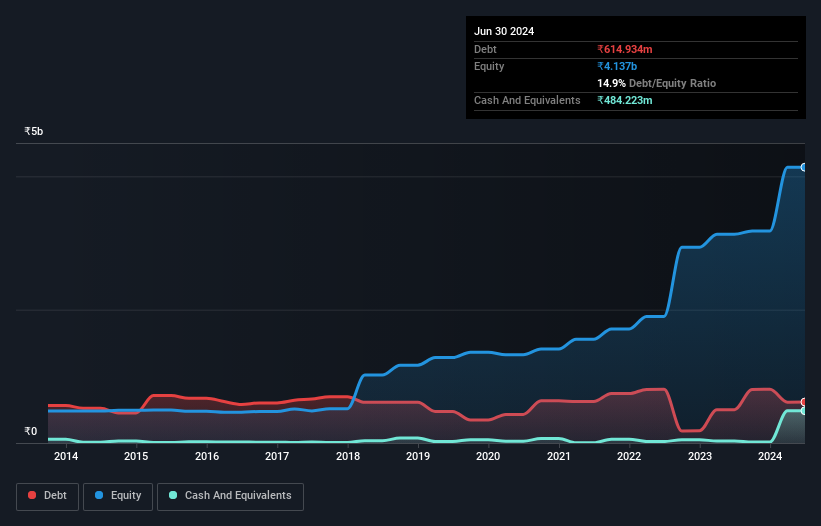These 4 Measures Indicate That Bhagiradha Chemicals & Industries (NSE:BHAGCHEM) Is Using Debt Extensively

Some say volatility, rather than debt, is the best way to think about risk as an investor, but Warren Buffett famously said that 'Volatility is far from synonymous with risk.' So it seems the smart money knows that debt - which is usually involved in bankruptcies - is a very important factor, when you assess how risky a company is. We can see that Bhagiradha Chemicals & Industries Limited (NSE:BHAGCHEM) does use debt in its business. But is this debt a concern to shareholders?
What Risk Does Debt Bring?
Debt and other liabilities become risky for a business when it cannot easily fulfill those obligations, either with free cash flow or by raising capital at an attractive price. If things get really bad, the lenders can take control of the business. However, a more usual (but still expensive) situation is where a company must dilute shareholders at a cheap share price simply to get debt under control. By replacing dilution, though, debt can be an extremely good tool for businesses that need capital to invest in growth at high rates of return. The first step when considering a company's debt levels is to consider its cash and debt together.
Check out our latest analysis for Bhagiradha Chemicals & Industries
What Is Bhagiradha Chemicals & Industries's Net Debt?
As you can see below, at the end of March 2024, Bhagiradha Chemicals & Industries had ₹614.9m of debt, up from ₹500.4m a year ago. Click the image for more detail. However, because it has a cash reserve of ₹484.2m, its net debt is less, at about ₹130.7m.

How Strong Is Bhagiradha Chemicals & Industries' Balance Sheet?
We can see from the most recent balance sheet that Bhagiradha Chemicals & Industries had liabilities of ₹1.26b falling due within a year, and liabilities of ₹368.1m due beyond that. On the other hand, it had cash of ₹484.2m and ₹1.07b worth of receivables due within a year. So its liabilities total ₹65.6m more than the combination of its cash and short-term receivables.
Having regard to Bhagiradha Chemicals & Industries' size, it seems that its liquid assets are well balanced with its total liabilities. So while it's hard to imagine that the ₹51.7b company is struggling for cash, we still think it's worth monitoring its balance sheet. Carrying virtually no net debt, Bhagiradha Chemicals & Industries has a very light debt load indeed.
In order to size up a company's debt relative to its earnings, we calculate its net debt divided by its earnings before interest, tax, depreciation, and amortization (EBITDA) and its earnings before interest and tax (EBIT) divided by its interest expense (its interest cover). The advantage of this approach is that we take into account both the absolute quantum of debt (with net debt to EBITDA) and the actual interest expenses associated with that debt (with its interest cover ratio).
Bhagiradha Chemicals & Industries has net debt of just 0.28 times EBITDA, indicating that it is certainly not a reckless borrower. And this view is supported by the solid interest coverage, with EBIT coming in at 7.7 times the interest expense over the last year. In fact Bhagiradha Chemicals & Industries's saving grace is its low debt levels, because its EBIT has tanked 34% in the last twelve months. When it comes to paying off debt, falling earnings are no more useful than sugary sodas are for your health. There's no doubt that we learn most about debt from the balance sheet. But it is Bhagiradha Chemicals & Industries's earnings that will influence how the balance sheet holds up in the future. So when considering debt, it's definitely worth looking at the earnings trend. Click here for an interactive snapshot.
Finally, a business needs free cash flow to pay off debt; accounting profits just don't cut it. So the logical step is to look at the proportion of that EBIT that is matched by actual free cash flow. During the last three years, Bhagiradha Chemicals & Industries burned a lot of cash. While that may be a result of expenditure for growth, it does make the debt far more risky.
Our View
Both Bhagiradha Chemicals & Industries's EBIT growth rate and its conversion of EBIT to free cash flow were discouraging. But at least its net debt to EBITDA is a gleaming silver lining to those clouds. Taking the abovementioned factors together we do think Bhagiradha Chemicals & Industries's debt poses some risks to the business. So while that leverage does boost returns on equity, we wouldn't really want to see it increase from here. When analysing debt levels, the balance sheet is the obvious place to start. But ultimately, every company can contain risks that exist outside of the balance sheet. To that end, you should learn about the 2 warning signs we've spotted with Bhagiradha Chemicals & Industries (including 1 which is concerning) .
Of course, if you're the type of investor who prefers buying stocks without the burden of debt, then don't hesitate to discover our exclusive list of net cash growth stocks, today.
If you're looking to trade Bhagiradha Chemicals & Industries, open an account with the lowest-cost platform trusted by professionals, Interactive Brokers.
With clients in over 200 countries and territories, and access to 160 markets, IBKR lets you trade stocks, options, futures, forex, bonds and funds from a single integrated account.
Enjoy no hidden fees, no account minimums, and FX conversion rates as low as 0.03%, far better than what most brokers offer.
Sponsored ContentValuation is complex, but we're here to simplify it.
Discover if Bhagiradha Chemicals & Industries might be undervalued or overvalued with our detailed analysis, featuring fair value estimates, potential risks, dividends, insider trades, and its financial condition.
Access Free AnalysisHave feedback on this article? Concerned about the content? Get in touch with us directly. Alternatively, email editorial-team (at) simplywallst.com.
This article by Simply Wall St is general in nature. We provide commentary based on historical data and analyst forecasts only using an unbiased methodology and our articles are not intended to be financial advice. It does not constitute a recommendation to buy or sell any stock, and does not take account of your objectives, or your financial situation. We aim to bring you long-term focused analysis driven by fundamental data. Note that our analysis may not factor in the latest price-sensitive company announcements or qualitative material. Simply Wall St has no position in any stocks mentioned.
About NSEI:BHAGCHEM
Bhagiradha Chemicals & Industries
Manufactures and sells crop protection chemicals in India, Asia, Australia, and Europe.
Excellent balance sheet with acceptable track record.
Similar Companies
Market Insights
Community Narratives




